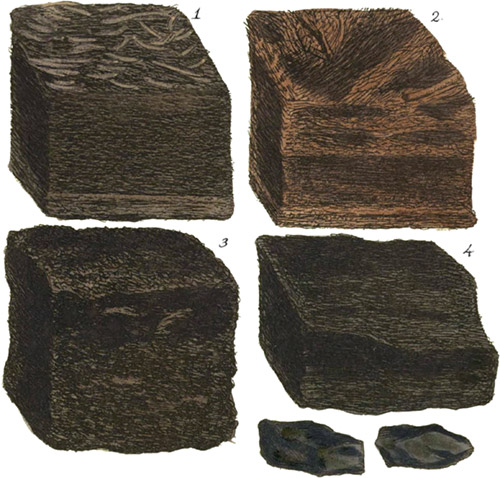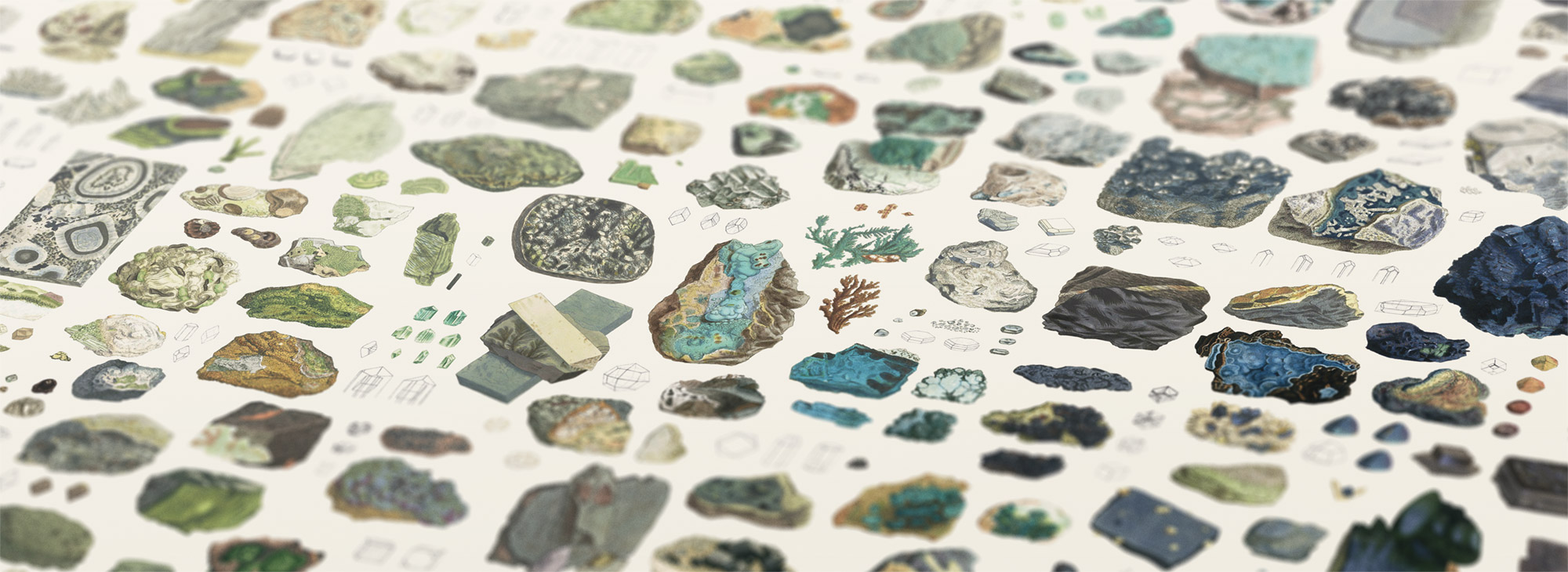 Enlarge
Enlarge
British Mineralogy
Turf and the return of vegetable into fossil or mineralized matter has been allowed as a mineralogical subject in many instances, and is highly providential. In numerous places in Great Britain there are large bogs which afford a cheap fuel, so essential an article in human economy, where it would be otherwise very rare. The plants peculiar to bogs of this kind are chiefly annuals which require but little earth, and having flourished for their season, subside on the bed, where nature preserves their remains in progressive stages from the oldest to the newest in succession for ages, to be produced and used periodically,* almost immediately, or as an heaped and lasting store for futurity, being as it were the simplest chemical agency to form a sort of coal, and that from the very surface of the earth, whether in valleys or on hills.
The first figure is the looser turf and upper surface, it shows the remains of decayed vegetables and is a little inflammable. The next figure, 2, is older, more compressed, and often in the state of touchwood; when dried if set on fire, it burns like a fusee; it is of a warm brown colour. Fig. 3 is a still more compressed sort, harder when dryed, and shines when sawed asunder; it is of a dark brown colour, and is longer burning. Fig. 4 is still more compressed and burdened, having, occasionally, dense black Carbon interspersed, see the lower figures; it represents a specimen from Ireland, where the others are also very common. The late Dr. Scott, of Dublin, who sent it me in 1800, observed this black substance separate in some of the bogs, appearing like a jelly, but when dried became black, dense, and brittle about as hard as charcoal, and burning with a poignant vegetable odour and without flame.
The third specimen is a variety gathered by Miss Codrington, at Muddiford, near Christchurch, Hants, and seems to have undergone so me further change, being very bard and somewhat porous, resembling Coke. Thus I have given the chief varieties of this curious substance. It may be proper to observe, that these while in the wet bog remain soft and more or less spongy; after drying they shrink much, and the denser ones are not to be softened again in water.
Thus Small annuals are resolved into a coaly substance retaining much of the character of vegetable extract on the uppermost surfaces of the earth in which the remains of trees are preserved for ages little changed; the next, surface, in the Clay stratum presents us with wood changed to what is tunned Plank and Bovey coal, tab. 188; the next and further change is the substance called Surturbrand, then succeeds the Alum Clay with the wood more dense and jet, tab. 51; but none of these belong to the common coal formation. Portland and Kimmeridge afford a bituminous Clay, possibly the bituminous infill tration may be owing to the stumps and remains of trees found replaced by stone. (See tabs. 163, 164, and 473.) The common coal basins, as they are usually called, are different, from either of these, and are under the more ponderous pressure of Sandstone, Limestone, &c. having the woody remains most distinct in the form of burned Charcoal, as at Newcastle, &c. with a brittle black admixture of Bitumen, tab. 48, also, most of the varieties, as Splint, &c. perhaps including the stone Coal of Wales; the Kilkenny Coal, and Natural Coke.
The Turf and Peat bogs in so me parts of Lancashire are highly impregnated with Petroleum; in oilier respects I presume they are the same, I have specimens of Turf with Gypsum about them by favour of Mr. Skrimshire from near Lynn, which, in some measure, show that the waters there held Gypsum in solution. It seems that the simplest operations of the seasons produce this useful substance as it were spontaneously: a very little earth washed in is a sort of casualty.
- * Being fit for fire turf in from four to six years.

